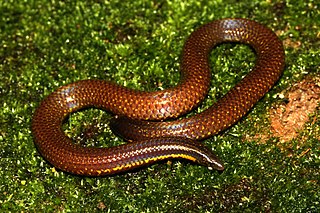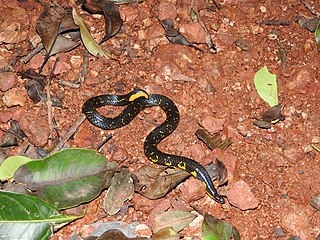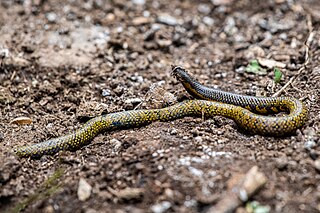Uropeltis beddomii, commonly known as Beddome's earth snake, is a species of snake in the family Uropeltidae. The species is endemic to India.
Uropeltis broughami, commonly known as Brougham's earth snake or the Sirumalai shieldtail, is a species of snake in the family Uropeltidae. The species is endemic to the Western Ghats in southern India.
Uropeltis ceylanica is a species of nonvenomous shieldtail snake in the family Uropeltidae. The species is endemic to the Western Ghats of South India. No subspecies are currently recognized as being valid, but the presence of several synonyms, many recently resurrected, calls for further taxonomic studies of this species complex. It is a burrowing snake with a pointy head equipped to penetrate the soil. It has a thick tail which looks as if it has been cut at an angle. In Kerala it's called iru thala moori, which means two headed organism, as the tail end looks like another head. It primarily eats earth worms.
Uropeltis dindigalensis, commonly known as the Dindigul uropeltis and the Sirumalai Hills earth snake, is a species of snake in the family Uropeltidae. The species is endemic to Sirumalai and surrounding hill ranges of the southern Eastern Ghats, in Dindigul district of Tamil Nadu state in South India.

Uropeltis ellioti, commonly known as Elliot's earth snake and Elliot's shieldtail, is a species of snake in the family Uropeltidae. The species is endemic to India.
Uropeltis liura, commonly known as the Ashambu shieldtail and Günther's earth snake, is a species of snake in the family Uropeltidae. The species is endemic to India.

Uropeltis macrolepis, commonly known as the Bombay earth snake, the Bombay shieldtail, and the large-scaled shieldtail, is a species of snake in the family Uropeltidae. The species is endemic to southern India. There are two recognized subspecies.
Uropeltis macrorhyncha is a species of nonvenomous snake in the family Uropeltidae. The species is endemic to India. There are no subspecies that are recognized as being valid.

Uropeltis maculata, also known commonly as the spotted earth snake and the spotted shieldtail, is a species of nonvenomous snake in the family Uropeltidae. The species is endemic to southern India. There are no subspecies that are recognized as being valid.
Uropeltis myhendrae, commonly known as Boulenger's earth snake, the Mahendragiri earth snake, and the Myhendra Mountain uropeltis, is a species of snake in the family Uropeltidae. The species is endemic to India.
Uropeltis ocellata is a species of non-venomous shieldtail snake in the family Uropeltidae. The species is indigenous to southern India. There are no subspecies that are recognized as being valid.
Uropeltis petersi, commonly known as Peter's earth snake, Peters' shieldtail, and the shieldtail earth snake, is a species of nonvenomous snake in the family Uropeltidae. The species is endemic to India.

Uropeltis phipsonii, commonly known as Phipson's earth snake and Phipson's shieldtail, is a species of snake in the family Uropeltidae. The species is endemic to India.

Uropeltis pulneyensis, commonly known as the Indian earth snake and the Palni shieldtail, is a species of snake in the family Uropeltidae. The species is endemic to the Western Ghats of India.
Uropeltis rubrolineata is a species of nonvenomous shieldtail snake in the family Uropeltidae. The species is endemic to southern India. There are no subspecies that are recognized as being valid.

Uropeltis rubromaculata is a species of nonvenomous shieldtail snake in the family Uropeltidae. The species is endemic to southern India. There are no subspecies that are recognized as being valid.
Smith's earth snake, also known commonly as the violet shieldtail, is a species of nonvenomous snake in the family Uropeltidae. The species is endemic to India.

Uropeltis woodmasoni, commonly known as Wood-Mason's earth snake or Woodmason's earth snake, is a species of snake in the family Uropeltidae. The species is endemic to India.

Uropeltis shorttii, also known commonly as the Shevaroy Hills earth snake and Shortt's shieldtail snake, is a species of non-venomous snake in the family Uropeltidae. The species is endemic to the southern Eastern Ghats of India. This species was first described as Silybura shorttii by British naturalist Richard Henry Beddome in 1863. It is found only in the Shevaroy Hills of Salem district in Tamil Nadu state in South India. For a long time, this species was misclassified into Uropeltis ceylanica, a snake endemic to the Western Ghats, till a recent taxonomic study proved it to be a distinct species with a very narrow geographic range. It is a burrowing snake, presumed to be nocturnal, feeding on soft-bodied worms. It becomes active during the rains. U. shorttii has most recently been assessed for The IUCN Red List of Threatened Species in 2019, and is listed as "Critically Endangered" under criteria B1ab(iii).

Uropeltis madurensis, also known commonly as the Madura earth snake and the Madurai shieldtail, is an endangered species of small, fossorial, nonvenomous snake of the family Uropeltidae. The species is endemic to the Western Ghats of South India.









